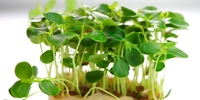The healthiest vegetable

Science reveals the truth There are many superfoods in the world of healthy eating, but one green stands tall thanks to its impressive nutritional profile and numerous health benefits. Watercress, with its small leaves and spicy taste, may seem unassuming, but it offers a wealth of vitamins, minerals and antioxidants, making it a must-have ingredient in any healthy diet. Here's why watercress has been named the healthiest vegetable according to scientific research, and how you can incorporate this amazing vegetable into your daily routine.
Watercress:
Nature's Superfood Watercress (Lepidium sativum) is a fast-growing edible herb that is native to the Mediterranean region. It is often used as a garnish or addition to salads, sandwiches and soups. This versatile vegetable has a delicate, slightly bitter taste that pairs well with a variety of dishes. But in addition to its pleasant taste, watercress is full of essential nutrients that contribute to our overall health and well-being. Rich in nutrients Watercress is an excellent source of several essential vitamins and minerals, including:
Vitamin A: Essential for good vision, a healthy immune system and red blood cell production. Vitamin C: A powerful antioxidant that supports immune function, collagen production and iron absorption.
B vitamins:
Especially vitamin B6, which plays a crucial role in metabolism, nerve function and brain development.
Potassium:
An important electrolyte that helps regulate blood pressure, heart rate, and muscle contractions. Iron: An essential mineral needed to make hemoglobin, a protein in red blood cells that carries oxygen around the body.
Calcium:
Necessary for healthy bones and teeth as well as normal neuromuscular function. Health benefits Regular consumption of watercress offers numerous health benefits, including:
Supports eye health:
Watercress' high vitamin A content supports eye health and can prevent night blindness and other eye disorders. Fights inflammation: Antioxidants in watercress, such as kaempferol and rutin, can help reduce inflammation in the body, which can help prevent chronic diseases such as heart disease, diabetes and cancer.
Supports respiratory health: Watercress is traditionally used to treat respiratory problems such as bronchitis, asthma and coughs. Its anti-inflammatory properties can help relieve these symptoms. Helps with weight loss: The low calorie and high fiber content of watercress makes it an ideal food for people trying to lose weight. Fiber also promotes feelings of fullness, which can help control hunger and food intake.
Improves skin health: Vitamins A and C in watercress contribute to the production of collagen, a protein that provides structure to the skin and keeps it smooth and elastic. These vitamins also help fight skin damage caused by the sun and pollution. How to include watercress in your diet With its mild, spicy flavor, watercress can easily be added to a variety of dishes.
Here are a few ways to incorporate this healthy vegetable into your daily routine: Add a handful of fresh watercress to your salad for a refreshing twist. Garnish sandwiches and burgers with watercress for extra flavor and crunch. Add watercress to smoothies or juices for a nutritional boost. Include watercress in omelets, scrambled eggs or stir-fry dishes for a healthy twist. We talk about... Use watercress instead of basil or cilantro in your favorite pesto, guacamole or salad dressing recipes. Watercress, with its diverse nutritional profile and numerous health benefits, deserves its place as the healthiest vegetable according to scientific research. By including this amazing green in your daily diet, you are making an investment in your health and well-being. So why not try adding some watercress to your next meal? Your body will thank you!


